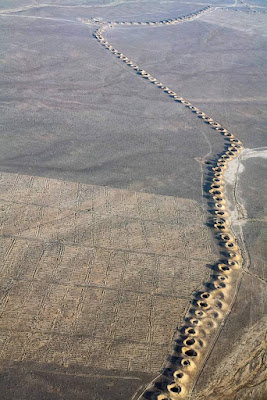3000 years ago a Marvelous underground water system was constructed in Iran, known as qanat .
A qanat is an underground Aqueduct that functions as a Sustainable watermanagement system. The construction of a qanat involves a series of carefully planned and engineered underground tunnels that tap into underground watersource, typically originating from mountains or hills. The tunnels slope gently downward, following the natural gradient of the terrain.
The process of creating a qanat begins with the identification of a suitable water source, such as a groundwater reservoir. Skilled workers, often referred to as muqannīs, manually excavate a vertical shaft from the surface down to the level of the water source. This shaft serves as the access point to the qanat system.
Once the initial shaft is established, workers then dig horizontally along the water table to create a tunnel. The tunnel is meticulously excavated, maintaining a gentle downward slope to facilitate the flow of water. The excavated soil is removed through the vertical shaft, ensuring minimal disturbance to the surface.
To provide oxygen to the workers during the excavation process, vertical holes, known as air shafts or kārīz, are periodically created along the tunnel. These air shafts allow fresh air to reach the diggers, ensuring a safe working environment underground. The air shafts also serve as access points for maintenance and repair of the qanat system.
The qanat system is designed to minimize water loss through evaporation or seepage. The tunnel is typically lined with materials like stone or clay to prevent water leakage, ensuring that a significant portion of the water reaches its intended destination. This efficiency in water transport enabled the growth of agriculture and settlement in previously inhospitable areas.
Qanats are characterized by their sustainable and environmentally friendly nature. By relying on gravity to transport water, they require no external energy sources for operation. Moreover, the underground nature of the qanat system helps conserve water by reducing evaporation, preventing contamination, and protecting the water supply from external factors like temperature fluctuations and pollution.
The qanat system played a vital role in the development of civilizations in arid regions. It provided a reliable and consistent water supply that sustained agricultural activities, facilitated the growth of settlements, and supported the livelihoods of communities. Even today, qanats continue to be utilized in some parts of the world, serving as a testament to the ingenuity and foresight of ancient engineers.
The construction and maintenance of qanats required considerable knowledge, skill, and collaboration. The development of this remarkable underground water management system stands as a testament to the resourcefulness and innovation of ancient societies, as well as their deep understanding of the importance of water in sustaining life in challenging environments.











Comments
Post a Comment